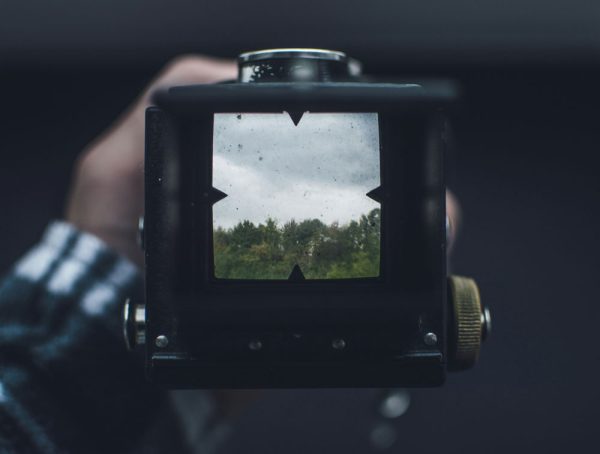
Inside the eye-arresting portraits of Indigenous photographer Olivia Cox capture the raw beauty of her ancestral spirit, feminine allure, and self-identity. As a recipient of YVR Art Foundation’s Emerging Artist scholarship of 2023, Olivia’s award-winning imagery speaks on fostering an enriched discourse surrounding the colonial gaze.
From producing experimental photographic materials to on-screen creations, Olivia passionately seizes intimate fragments of her vibrant inner sphere through the curious shutters of a camera. Her current oeuvre, which features visually riveting pieces centered on preserving organic moments of family, cultural identity, and self-exploration, attests to her storytelling prowess. Yet for many Indigenous creators, under-resourced programs and career insecurity remain a stagnant phenomenon within Canada’s art sector.
“The contemporary Indigenous art circle is kind of small enough in Vancouver that I knew people from work and my personal social circles,” says Olivia. Confidence and enthusiasm radiate in her speech as she articulates the costly challenges of maintaining her profession within a metropolitan artistic scene. “Of course, Vancouver is such an expensive place to live in, especially when you are making art. That is not exactly the most secure, financially-speaking, thing to do. I am always digging around to see what opportunities are available.”
Racialized pay gaps and inequitable funding to creative production have significantly led to undervalued representation within Indigenous artistic spaces. Hill Strategies revealed a 2016 census report highlighting a vast income disparity in which Indigenous creators are generating 68 cents for every dollar their Caucasian counterparts produce. Furthermore, the report attributes gender bias to exacerbating the unequal pay, stating Indigenous women make 21 percent less than non-racialized male workers. As Vancouver’s cost of living dangerously fluctuates, many aspiring Indigenous artists lack access to financial subsidies to sustain their careers.
“People don’t often think about how artists need support across the continuum of their careers,” says Elisabeth Kyle, executive director at YVR Foundation. The independent charity aims to earmark copious research opportunities and scholarship awards to preserve Vancouver’s indigenous artistic milieu. From the fabrics of intricate embroideries to the earthly minerals that produce ochre paintings, the foundation’s mandate aims to provide early Indigenous artists equitable access to financial resources. “An artist does a huge expense upfront before anything is even sold. So, you might have to buy materials, rent studio spaces, or buy some tools. These are all super costly things, so we like to have mid-career artists get there as well.”
In search of a scarce opportunity to display her talent, Olivia discovered YVR Foundation’s Emerging Artist Scholarship during her intern position at Bill Reid Gallery of Northwest Coast Art. There, she was introduced to Elisabeth, the former development manager who encouraged her to apply after she was apprised of Olivia’s growing oeuvres around candid photography and video production.
“The Emerging Artist Scholarship is a powerful one because it is where it all starts,” says Elisabeth. “You can’t have a mid-career artist if you don’t have an emerging artist, and you can’t carry forward traditions of material culture without someone expressing interest to learn more about it.”
Although Elisabeth is optimistic about the influx of applicants sending eye-arresting submissions, the deliberation process behind selecting a recipient can be tedious due to limited financial resources. However, the organization’s large network of board members—spanning from acclaimed Indigenous artists to museum educators—holistically examine an applicant’s background to determine an impartial decision.
“In the handful of photos that I applied for the award; I was just trying to show a good variety in my photography skills,” says Olivia. Her undergraduate studies at the University of British Columbia and current enrolment in a digital film-making program at Capilano University informed her practice on influential discourses surrounding non-western art. Steering away from oriental depictions of Indigenous culture, Olivia sought to disarm her camera as a traditional weapon of colonial oppression by creating a safe, intimate space for subjects.
“I was taking Indigenous or non-Western-focused art classes,” says Olivia. “We were talking about how a lot of the time, old photographs that you see of people are taken by foreigners or colonial figures within that space”. She asserts the historical legacy surrounding the Western gaze in art has dehumanized Indigenous tribes to a merely uncivilized, exotic spectacle. From body ornamentation to basket weaving, cultural materials that embody ancestral customs dating back to the Pre-Columbian era have now been hollowed artifacts within the glass cases of globally renowned museums. “So, I had lots of conversations like that, and it made me feel very curious and inspired by how I, as an Indigenous person, was handling the camera.”
“That is the lasting impact of the Foundation’s work,” says Elizabeth. “It dispels ideas of what Indigenous art is and what it can be. Sometimes people have an idea that it is what they see in a museum.” In fact, surging new technology has shifted the plate tectonics of modern art. As a result, young Indigenous artists espousing digital media into their ancestral practices have conditioned a new wave of cultural resurgence. This unique meld has allowed First Nation creators to sculpt empowered visual narratives that carry an eternal legacy. “By creating these programs, we are creating a pathway to help these artists bring forward their material culture to the next generation and beyond.”
As a result of her informed artistic practice, the award-winning monochromatic “I See You” imagery was born through the piles of Olivia’s chemically unprocessed photos. Her submission features a freckled girl with long vibrant ginger tresses, whisked away by the soft breeze of VanDusen’s Garden as she holds a translucent leaf in front of her eyes, capturing a sacred moment of ethereal beauty.
“It was with my friend Jenna, who is mixed Métis. I love taking pictures of my friends. I feel comfortable taking pictures of people I know,” says Olivia. She asserts traditional themes of colonial gaze across visual materials can be identified in the relationship between a camera and its human subjects, an alienating and superficial barrier that often deprives a photograph of its authenticity. “Having a genuine relationship with your subjects is key. You don’t have to be friends or close. But even just establishing a comfortable level of friendliness, I feel like that really allows people to unfurl and become comfortable in front of the camera.”
In addition to her photo submission, Olivia produced a nine-minute video collage titled Home, composed of various clips showcasing the Yukon artist’s solace journey towards self-discovery. From placid walks around the lapis blue tides that encircle Yukon to the summer breeze gently stroking a patch of luscious green grass, Olivia’s camera captures organic moments of blissful intimacy throughout endless drives with her mother and best friend. “When I think of going to the airport, I think of going home,” says Olivia. “I really try to choose places that are meaningful to me but also to the relationship I share with that person.”
From body ornamentation to ceremonial dances, Indigenous artistic rituals have historically proven to be an effective wellness intervention in vitalizing cultural spaces that allow creators to foster pride and ownership in their storytelling process. “We call it art in the West but for Indigenous people, it is their way of life,” says Elisabeth. “So, we are talking about art objects that are used in ceremonies and have a cultural purpose within the community. I think the idea of a canvas on a wall just to look at is a very modern concept.”
In fact, a plethora of academic literature has proven artistic engagement can be used as a potent vehicle in sculpting empowered cultural narratives from the ashes of historic atrocities and oppressed ancestral voices. In promoting equitable access to creative resources and opportunities, the bedrock of YVR Art Foundation recognizes art as a medicinal property in revitalizing autonomy in cultural expression. From on-screen works to performance production, Elisabeth feels the flaring ambitions of today’s young Indigenous creators to expand contemporary interpretations of ancestral art will help fuel their cultural existence.
“Without tending and nurturing that flame. There is no legacy, there is no mid-career artist or Robert Davidson for the future.” says Elisabeth.
***
Sara is currently a fourth-year journalist student at Guelph-Humber University. She has always harbored an undying passion for educating readers on complex political phenomena, from localized events to international headlines. She is always on the lookout for opportunities to expand her political knowledge and enjoys crafting words to promote inclusive discourse on important public issues.




